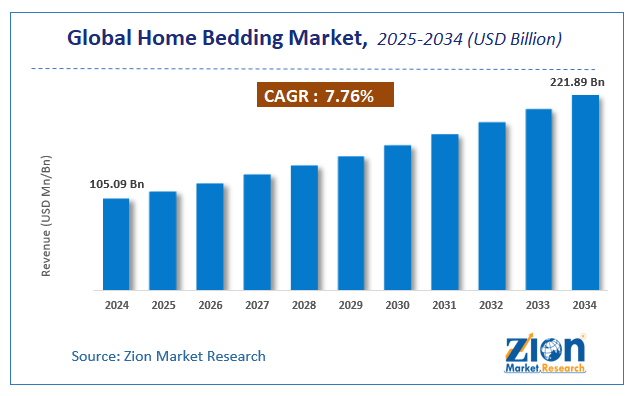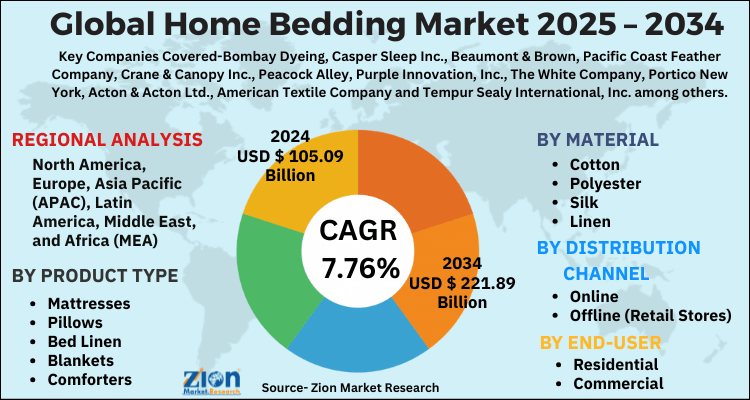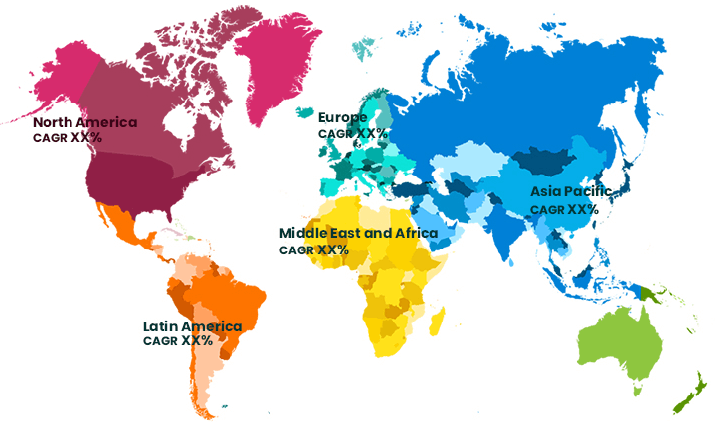Global Home Bedding Market Size, Share, Growth Analysis Report - Forecast 2034

Home Bedding Market By Product Type (Mattresses, Pillows, Bed Linen, Blankets, Comforters, Others), By Material (Cotton, Polyester, Silk, Linen, Blends), By Distribution Channel (Online, Offline (Retail Stores, Department Stores, Specialty Stores)), By End-user (Residential, Commercial (Hotels, Hospitals, Dormitories)), and By Region: Global and Regional Industry Overview, Market Intelligence, Comprehensive Analysis, Historical Data, and Forecasts 2025 - 2034
| Market Size in 2024 | Market Forecast in 2034 | CAGR (in %) | Base Year |
|---|---|---|---|
| USD 105.09 Billion | USD 221.89 Billion | 7.76% | 2024 |
Home Bedding Industry Perspective:
The global home bedding market size was worth around USD 105.09 Billion in 2024 and is predicted to grow to around USD 221.89 Billion by 2034 with a compound annual growth rate (CAGR) of roughly 7.76% between 2025 and 2034. The report analyzes the global home bedding market's drivers, restraints/challenges, and the effect they have on the demands during the projection period. In addition, the report explores emerging opportunities in the home bedding industry.
The report analyzes the global home bedding market drivers, restraints/challenges, and the effect they have on the demands during the projection period. In addition, the report explores emerging opportunities in the home bedding market.
Home Bedding Market: Overview
Home beddings are fabrics that can be washed that are placed above the bed for hygienic, esthetic, and comfort reasons. These materials often consist of comforters, duvets, sheets, pillows, mattresses, linens, pillows, cushions, rugs, and blankets. They support and relax the neck and back, ease pressure spots, and contour the body to facilitate sleep. Due to rising disposable incomes and the ease with which products can be found in a variety of colors, designs, and sizes to suit individual demands, the demand for home bedding is currently significantly increasing.
Key Insights
- As per the analysis shared by our research analyst, the global home bedding market is estimated to grow annually at a CAGR of around 7.76% over the forecast period (2025-2034).
- Regarding revenue, the global home bedding market size was valued at around USD 105.09 Billion in 2024 and is projected to reach USD 221.89 Billion by 2034.
- The home bedding market is projected to grow at a significant rate due to increasing urbanization, rising consumer spending on home decor, and growing demand for premium, comfortable, and health-oriented bedding products.
- Based on Product Type, the Mattresses segment is expected to lead the global market.
- On the basis of Material, the Cotton segment is growing at a high rate and will continue to dominate the global market.
- Based on the Distribution Channel, the Online segment is projected to swipe the largest market share.
- By End-user, the Residential segment is expected to dominate the global market.
- Based on region, North America is predicted to dominate the global market during the forecast period.
Home Bedding Market: Growth Drivers
Eco-friendly bedding is becoming more popular and is expected to drive the market growth
The environment and ecology are being given a lot of attention. Organic bedding options like natural silk bedding and natural mattresses are becoming more and more popular with consumers. Silk bed sheets are the most common type of natural bedding, although wood and silk bedding are also available. Silk sheets are good for the environment and for the skin and hair.
The most hypoallergenic fabric is silk, which is chemical-free and made entirely of organic materials. Therefore, the best option for populations with allergies is silk bedding. With rising living standards, buying silk blankets, pillowcases, and comforters has become a popular trend among many individuals. Alterra Pure, Anna Sova, Boll & Branch, Cariloha, and CB2 are some businesses that make dependable and environmentally friendly bed linens and bedding. The Global Organic Textile Standard (GOTS), CertiPUR-US Certified, and USDA Certified Organic are just a few examples of environmentally friendly certifications that are essentially concerned with the well-being of the world. Throughout the anticipated period, these factors will continue to drive the expansion of the global home bedding market.
Home Bedding Market: Restraints
Fluctuation in the price of fabric materials impedes the market growth
The fluctuation in the price of fabric materials is expected to hamper the home bedding industry expansion over the forecast period. The fabric materials include polyester and others are made from petroleum, the fluctuation in the price of crude oil directly impacts the price of polyester. For instance, according to the secondary analysis, the average OPEC oil price for the year 2024 was $100.08 per barrel. As a result of a lack of energy supplies and sanctions on Russia following the Russia-Ukraine war, this amount has increased from the 69.89 USD of the previous year. Thereby, the fluctuation in crude oil prices might be impacted the market growth to a certain extent.
Home Bedding Market: Opportunities
Technological advancements are expected to provide a significant opportunity
The expansion of the global bedding market is being driven by technological advancements. In the field of bedding, SleepMaker is responsible for many technological breakthroughs that were world debuts. The responsive heat management fabric treatment used by SleepMaker, which is designed to react to changes in body temperature, helps to maintain the ideal temperature throughout the night. This innovative heat-management method works independently throughout the bed, adapting to individual body temperatures to ensure a more comfortable night's sleep. The resulting cool, dry sleeping environment is also more hygienic and will help the mattress last longer. The luxurious Climatex Quilt sleep surface from SleepMaker combines Dreamfoam and superior high-loft fiber. Dreamfoam's ultra-fine structure allows for the most breathability and the least amount of heat buildup.
Home Bedding Market: Challenges
Real silk is unethical and poses a major challenge
The unethical nature of silk production is one of its key drawbacks. Silkworms are cooked alive in their cocoons to generate real silk bedding. The silk is then carefully retrieved and weaved into a luxurious material. In actuality, about 2,500 silkworms are normally required to make only one pound of silk. Thus, this act as a major challenging factor for the home bedding market growth during the forecast period.
Home Bedding Market: Segmentation
The global home bedding industry is segmented based on product type, fabric materials, distribution channel, and region.
Based on the product type, the global market is bifurcated into sheets, bed covers, pillows, bed linens, blankets, and mattresses. The bed linens segment captures the largest market share during the forecast period. Sheets, covers, pillow cases, and duvet covers are examples of bed linens. One of the main factors driving category expansion is a swift movement in consumer preferences towards high-quality, eco-friendly bedding products that promote healthier beds, more comfort, and durability. Interest in interior design and home decor has increased as individuals spend more time at home. Consumers are prepared to spend money on high-quality, visually appealing bedding products that can improve the look and feel of their bedrooms because bed linens are an important part of bedroom design.
Based on the fabric materials, the global home bedding industry is divided into cotton, linen, Tencel, acetate, silk, polyester, bamboo, and blends. The polyester segment is growing at a significant rate during the forecast period. Polyester is regarded as a very durable fiber. Polyester straps are reputed to be more durable than steel. Most chemicals, alcohol, and oils do not easily destroy it. When washed, it is also resistant to stretching and shrinking. Unlike natural fibers, it is still sturdy when wet.
Based on the distribution channel, the market is segmented into online and offline. The offline segment is expected to capture the largest revenue share during the forecast period. Shoppers prefer offline channels because they allow them to see the products in-person, which makes it easier to check the products' quality and materials. Before making a purchase, many individuals like to touch and feel the bedding materials, especially things like sheets and blankets. They can get a better sense of the quality and style of the product by touching the fabric's texture and seeing the colors and patterns in person. Customers may take bedding they purchase in a physical store home right now without having to wait for shipping or delivery. Thus, this is expected to drive segmental growth over the forecast period.
In terms of End-user, the global home bedding market is categorized into Residential, Commercial (Hotels, Hospitals, Dormitories).
Recent Developments:
- In January 2022, the most recent enhancements to the 360 Smart Bed line from Sleep Number, a producer of intelligent mattresses and bedding goods, include the capability to identify potential sleep issues like insomnia and sleep apnea. Advanced sleep tracking technology and biometric sensors are being used by Sleep Number to offer consumers personalized solutions to help them get better sleep and solve common sleep issues.
- In February 2021, Tempur Sealy International, Inc. unveiled a completely new, increased mattress lineup. The new mattresses include innovations like breathable, cool-to-the-touch covers to keep customers cool throughout the night as well as technologies that improve support and durability, like memory foams and ultra-responsive coils.
- In October 2021, a superior direct-to-consumer mattress platform was developed by Brooklyn Bedding and Helix Sleep after being acquired by Cerberus, a global leader in alternative investing with headquarters in the USA. This acquisition offers a wide range of excellent services, merged capabilities, and a better, more enjoyable mattress-buying experience. Helix is a cutting-edge direct-to-consumer brand platform that manages a portfolio of home goods and sleep businesses with headquarters in the US. An American mattress manufacturer with outstanding craftsmanship is Brooklyn Bedding.
Home Bedding Market: Report Scope
| Report Attributes | Report Details |
|---|---|
| Report Name | Home Bedding Market |
| Market Size in 2024 | USD 105.09 Billion |
| Market Forecast in 2034 | USD 221.89 Billion |
| Growth Rate | CAGR of 7.76% |
| Number of Pages | 213 |
| Key Companies Covered | Bombay Dyeing, Casper Sleep Inc., Beaumont & Brown, Pacific Coast Feather Company, Crane & Canopy Inc., Peacock Alley, Purple Innovation, Inc., The White Company, Portico New York, Acton & Acton Ltd., American Textile Company and Tempur Sealy International, Inc. among others., and others. |
| Segments Covered | By Product Type, By Material, By Distribution Channel, By End-user, and By Region |
| Regions Covered | North America, Europe, Asia Pacific (APAC), Latin America, The Middle East and Africa (MEA) |
| Base Year | 2024 |
| Historical Year | 2020 to 2023 |
| Forecast Year | 2025 - 2034 |
| Customization Scope | Avail customized purchase options to meet your exact research needs. Request For Customization |
Home Bedding Market: Regional Analysis
The Asia Pacific is expected to dominate the market during the forecast period
The Asia Pacific is expected to dominate the global home bedding market during the forecast period. The region's home textile market is dominated by nations like China, India, and Japan. As a result, bedding textiles are widely accessible, which encourages the use of bedding products in both domestic and commercial settings. A surge in disposable income has been observed in several Asia-Pacific nations, which has increased consumer expenditure on bedding and other home furnishings.
People are willing to spend more money on higher-quality bedding items that provide comfort and durability when they have more money to spend. According to the secondary analysis, Singapore's anticipated disposable income per capita within the ASEAN region would be roughly 29.9 thousand dollars. Nevertheless, it was expected that Vietnam will have the greatest CAGR for the population of medium income from 2016 to 2021, at 10.1%. Rapid urbanization has increased the number of homes across many nations, expanding the demand for bedding products.
For instance, according to the United Nations Human Settlements Programme, a major megatrend in the Asia-Pacific region is still urbanization. More than 2.2 billion people, or 54% of the world's metropolitan population, reside in Asia. Asia's urban population is projected to increase by 50% by 2050, or by an additional 1.2 billion people.
North America is expected to grow at the highest CAGR during the forecast period owing to the growing consumer awareness of the need of getting enough sleep and using the right bedding materials. The prevalence of sleep disorders has altered how consumers in the region see high-quality sleeping products. A study that looked at suburban high school students in Fairfax County, Virginia who had very early start times for school in 2020 found that each hour of sleep a teen lost was connected to a 38% increase in desolation feelings and a 42% increase in suicidal thoughts, according to a blog by AffordableCollegesOnline.org. Additionally, each hour of lacking sleep was associated with a 58% rise in actual suicide attempts.
Home Bedding Market: Competitive Analysis
The report provides a company market share analysis to give a broader overview of the key market players. In addition, the report also covers key strategic developments of the market, including acquisitions & mergers, new product launches, agreements, partnerships, collaborations & joint ventures, research & development, and regional expansion of major participants involved in the home bedding market on a global and regional basis.
The global home bedding market is dominated by players like:
- Bombay Dyeing
- Casper Sleep Inc.
- Beaumont & Brown
- Pacific Coast Feather Company
- Crane & Canopy Inc.
- Peacock Alley
- Purple Innovation Inc.
- The White Company
- Portico New York
- Acton & Acton Ltd.
- American Textile Company and Tempur Sealy International Inc.
The global home bedding market is segmented as follows;
By Product Type
- Mattresses
- Pillows
- Bed Linen
- Blankets
- Comforters
- Others
By Material
- Cotton
- Polyester
- Silk
- Linen
- Blends
By Distribution Channel
- Online
- Offline (Retail Stores
- Department Stores
- Specialty Stores)
By End-user
- Residential
- Commercial (Hotels
- Hospitals
- Dormitories)
By Region
- North America
- The U.S.
- Canada
- Mexico
- Europe
- France
- The UK
- Spain
- Germany
- Italy
- Rest of Europe
- Asia Pacific
- China
- Japan
- India
- Australia
- South Korea
- Rest of Asia Pacific
- The Middle East & Africa
- Saudi Arabia
- UAE
- Egypt
- Kuwait
- South Africa
- Rest of the Middle East & Africa
- Latin America
- Brazil
- Argentina
- Rest of Latin America
Table Of Content
Methodology
FrequentlyAsked Questions
A flat or fitted bed sheet that covers the mattress is referred to as "home bedding" and is often included with a bedding set to create a pleasing aesthetic and comfort for individuals who live in houses. Home beddings are hygienic, aesthetically pleasing, and washable products that are positioned above the bed. Bed linen or bedclothes are other names for household bedding.
The global home bedding market is expected to grow due to increasing urbanization, rising consumer spending on home decor, and growing demand for premium, comfortable, and health-oriented bedding products.
According to a study, the global home bedding market size was worth around USD 105.09 Billion in 2024 and is expected to reach USD 221.89 Billion by 2034.
The global home bedding market is expected to grow at a CAGR of 7.76% during the forecast period.
North America is expected to dominate the home bedding market over the forecast period.
Leading players in the global home bedding market include Bombay Dyeing, Casper Sleep Inc., Beaumont & Brown, Pacific Coast Feather Company, Crane & Canopy Inc., Peacock Alley, Purple Innovation, Inc., The White Company, Portico New York, Acton & Acton Ltd., American Textile Company and Tempur Sealy International, Inc. among others., among others.
The report explores crucial aspects of the home bedding market, including a detailed discussion of existing growth factors and restraints, while also examining future growth opportunities and challenges that impact the market.
RelatedNews
HappyClients
Zion Market Research
Tel: +1 (302) 444-0166
USA/Canada Toll Free No.+1 (855) 465-4651
3rd Floor,
Mrunal Paradise, Opp Maharaja Hotel,
Pimple Gurav, Pune 411061,
Maharashtra, India
Phone No +91 7768 006 007, +91 7768 006 008
US OFFICE NO +1 (302) 444-0166
US/CAN TOLL FREE +1 (855) 465-4651
Email: sales@zionmarketresearch.com
We have secured system to process your transaction.
Our support available to help you 24 hours a day, five days a week.
Monday - Friday: 9AM - 6PM
Saturday - Sunday: Closed







